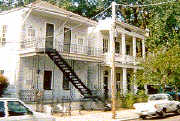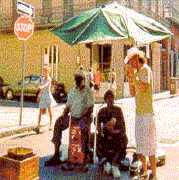
![]()
I had been in Houston for a few weeks. I had seen the Houston Astros play baseball, and the Texas A+M college football team. Both events were on a huge scale, a college game having 80,000 people in attendance is unheard of in England. To be honest with you I was amazed at the Texans response, all the crowd was going crazy with ecstatic excitement but to me the game was weak. It seemed like the players barely played 10 minutes before they were substituted. The pads and helmets ensured that the ‘athletes’ could barely feel a thing. Compare this to a game of Rugby in Twickenham, London, and it made the players look pathetic. Everything in Houston is big, it seems Texans pride themselves of the size of their truck not what it can do.
My time here was enjoyable but I was excited about leaving, seeking other experiences. The musical history of New Orleans really dragged me towards the city; the rich heritage of Jazz and Blues made me tingle all over with sheer excitement. I also was writing my University Dissertation on the works of Tennessee Williams, who lived and wrote in New Orleans, many of his plays being heavily influenced by the place, and this gave me an added desire to experience the city.
The Greyhound bus ride from Houston to New Orleans was a menagerie of oppositions. From one end of this journey to the other the pace and size of life had changed, from the monstrous, sky scraping office blocks of Houston to the sleepy dusty side streets of New Orleans. From the endless straight highways loaded with traffic, to the odd passing dirty truck. From suburbia with automatic garage doors, to warm porches with wooden floors. From hot and sweaty people rushing to get to work on time, to folks sitting out enjoying the pleasant sunshine. From a city where the only way to travel was to own your own giant truck, to one with a tram service that runs all through the city.

![]()
It was late September. The renowned Mardi Gras had been and gone. The tourists had finished their holiday season, yet the magic of New Orleans was all still there. I caught the Streetcar to Marquettte House, the name of my hostel.
From the Greyhound station, a short walk up Howard Street took me to the streetcar line that runs up St. Charles Avenue. I stayed on the streetcar for 13 blocks, where an adjacent road called Carondelet housed the international hostel. The ride highlighted certain differences in standards of living. On one side of the street were the grand houses of the ‘garden district,’ while just over the road were ‘the ghettos’ of New Orleans, where standards of living were visibly poorer.

![]()
On the streetcars there was no ticket system -you were simply trusted to drop the correct change into a box behind the driver. I did not know the correct change for the journey, so I dropped in enough coins to make it sound like the right amount. It seemed like the place and the pace of the place had barely changed since Williams wrote A Streetcar Named Desire in 1947. I didn’t see a streetcar heading for Desire, but I did see a bus going that way. If you are interested in Literature, then for about 10 dollars you could organize a trip with a company called ‘Heritage Tours’. This tour company celebrates the rich literary history of New Orleans with about 60 authors who lived, loved and worked in the city, including Tennessee Williams of course, along with other great names such as William Faulkner and Oscar Wilde.
I felt desire on the streetcar at the sight of a beautiful girl, but she got off the stop before me. I later realized I had missed my stop. I’d got off a little late, so I wandered back to my hostel – I might see her again, and I couldn’t wait. On the walk from the streetcar stop to my Hostel I passed drunks spending the day chatting to people walking by, and locals passing the time by lazing on verandas. I was sitting by a church across the street from one such group of people, and they invited me to sit with them to pass the time.
When I got to the hostel I ran into the girl I’d seen on the streetcar. This made my day: her name, of all things, was London, and she was from north of Oregon. We spent a few days together, a magic experience! I’ll never forget it. I booked a bed in a dorm at the hostel, and from there explored what other beauty the city had to offer.
A trip to Preservation Hall captured the atmosphere. At first I could not find the venue as it was not distinctly marked; it looked as though it had been boarded up – in fact the only way I could tell that I was in the right place was by the excited line of people queuing up outside.

![]()
Inside was more of the same story: a dimly lit room with dirty windows and crumbling walls hanging dusty pictures. No microphones to be seen or heard, just a dented upturned tin for tips in front of a piano, drums and a few chairs. The performers, casual and interspersed, wandered in and started to warm up their instruments. The musicians sat around one side of the small room. A few benches seated the small audience on the other. I sat on the floor, a foot in front of the band, to make space for others to sit.
Jazz began, the most proficient I have ever heard. The music that followed was not only breathtaking but also unbelievable: truly an amazing sound and sight. The laid-back attitude of the musicians, all over 50, highlighted the skill and proficiency with which they played. The small audience was suitably enthralled by the performance, the tin for tips overflowed and all the requests were played. There is a board on the wall with some classic tracks that are always requested; beside each track name is a price which is the minimal tip that should be given for a certain track to be played. The track requiring the biggest tip was ‘When The Saints Go Marching In’. All the requests were paid for, then played. Sort of like an old fashioned Juke box. I spent a few hours in awe of the skill some people have and purchased a CD for my Uncle who loves Jazz.
He recommended a trip to Preservation Hall in the first place, having been several times himself in the 50s. I wandered on.
The next remarkable thing that happened came after watching two musicians play the blues for a couple of hours in the middle of a lonely side street.

![]()
They attracted quite a crowd. Huddles of people came and went, some parted with their change, others didn’t. One of the street musicians would ask the odd passerby for a donation. I had been sitting, watching for a couple of hours, so the time came for him to ask me. I asked him if, in exchange for a small donation, I could sing with him as I had written my own blues lyrics. He agreed (with a little gentle persuasion on my part), and I spent a while singing my own material with their guitar and harmonica accompaniment.
The advantage of the blues is that it is possible to make nearly any blues lyric fit a blues guitar riff. This magic experience merely added to the beauty of New Orleans. Fortunately I had given my camera to an audience member to capture the moment, so the picture formed the front cover of my first blues album with a band at University.
I was now to travel to the West Coast to see if I could match the amazing feeling these experiences had left me with. New Orleans is a different kind of city than any other I have come across. The atmosphere is warm and friendly, though my only piece of advice is not to wander too far from the main streets, as parts of New Orleans are very poor and crime is a possibility. As in any city, it is best to keep your wits about you.
Otherwise, the ‘buzz’ of New Orleans goes all through the night – even in late September. So be prepared for a party, shake at the shindig, and get set for a celebration!
Questions?
If you want more information about this area you can email the author or check out our North America Insiders page.